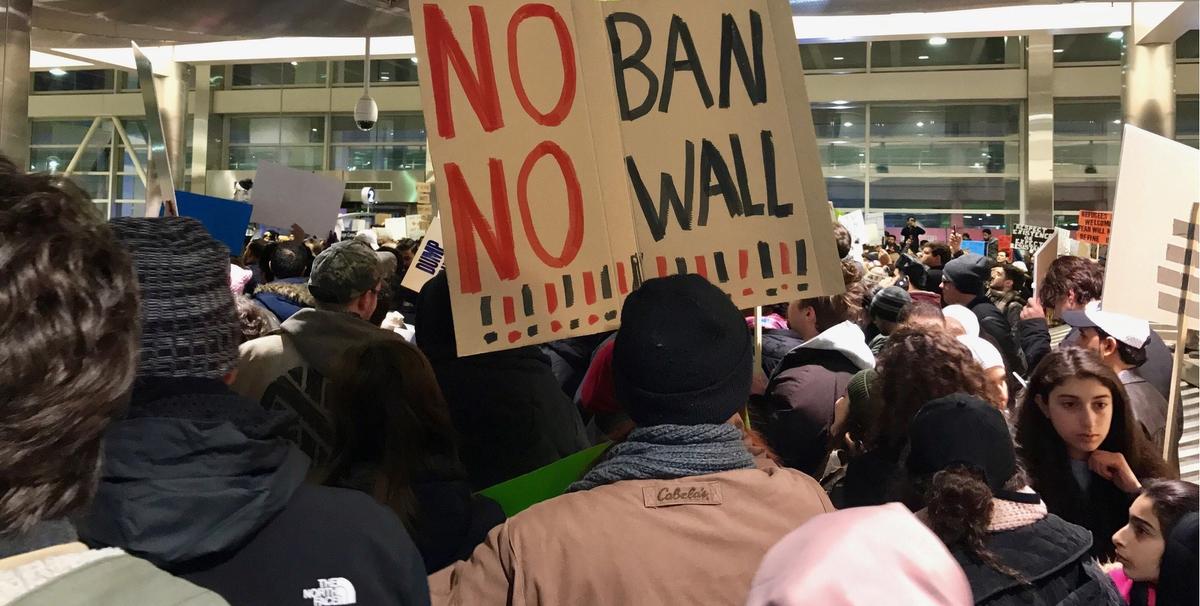Artists and curators working with Middle Eastern and Iranian art have spoken of the chilling effect of the US travel bans on their work. New rules and worsening attitudes, along with continued issues with financial controls, threaten to close off growing cultural exchanges between artistic communities between New York and Tehran, they warn.
Two Iranian artists, confused about their status as green card holders and worried about not being readmitted to America, called off plans to travel from the US to Canada for the opening of a show of contemporary Iranian art at the Aga Khan Museum this week. But even US passport holders and long-term residents say they feel threatened and insecure, in particular with reports that the Trump administration plans to cut off funding for the National Endowment for the Arts.
The Iranian-Canadian editor of Reorient magazine, a significant web publication on the art of the region, says he had called off any travel to the US for now. “They’ve said that we Canadians are not to worry, but I don’t believe it,” Joobin Bekhrad says. “I’ll miss out on those exhibitions, etc., but I don’t think they’re worth the humiliation.”
There have been several significant exhibitions of Iranian artists in the US, and the Warhol Museum confirmed yesterday that is going ahead with one by the US-Iranian artist Farhad Moshiri, titled Go West, in October. “The artist addresses contemporary Iran’s traditions and historic isolationism while simultaneously acknowledging the powerful appeal and influence of Western culture in his homeland,” a spokesman says.
But Roya Khadjavi-Heidari, who last year staged a show of Iranian and Cuban work at New York’s Rogue Space, says she is concerned about a planned exhibition in April of 30 works by three brothers from northern Iran, Morteza, Mojtaba and Sina Ghasemi.
Khadjavi-Heidari is heavily involved in educational exchanges. Of the travel ban on refugees and arrivals from seven mostly Muslim countries, she says: “I don’t think it was thought through and it’s going to have a lot of complications going forward. Artwork was never part of the sanctions; art was not part of it and we were able to bring art in easily.”
Now, she says, “to get these 30 paintings into the US on time. I am worried, and for sure these artists are not going to get their visas on time. It really is a bother.”
In Paris, the leading curator Leila Varasteh, who played a key role in organising the exhibition by the Belgian artist Wim Delvoye at Tehran’s Museum of Contemporary Art last year, along with many other art shows, says it was already a huge struggle to ship Iranian art to places like France, due to financial sanctions still in place, driven by the US but enforced by European countries.
“I can’t bring art out, I can’t pay the artists if I do, they blocked my accounts,” she says. “There was a little time of hope during the Obama administration, it’s gone. It’s a pity because the cultural exchanges between the US and Iran were fantastic. Anything creative coming out of Iran is being completely shut down. Inside Iran, and every Iranian outside of Iran as well.”
The backlash against the rules, with protests in the US and Europe, meant “in the last 48 hours my faith is being restored,” she says.
The Iranian-born, Brooklyn-based artist Bahar Behbahani is currently staging an exhibition, Let the Garden Eram Flourish, a suite of paintings, installations, and video, with the Hood Museum of Art in Dartmouth, New Hampshire. While Behbahani is a dual citizen, she says that she no longer feels secure even with a US passport.
Behbahani has been hailed for a series of work focussed on Persian gardens. In 2007, she says, she made a film Suspended, about a woman in Iran who is looking around a perfect “lyrical” backyard garden, but is doing so suspended upside down. Last week she felt the same dislocation and sense of strangeness in the US, she says. “After almost ten years the first thing that I felt just rushed to me, that same feeling. I found myself again hanging upside down,” she says.
“For the last week it’s not only that I got confronted by my nationality but also as being an artist, no matter where you come from, when you get threatened by the news that art funding might get eliminated, that is also a threat,” she says. “It’s not just about me, there are so many Americans who feel upside down too, economically, from all other aspects. It’s a very difficult time for everybody.”
The Iranian artist Shahpour Pouyan, living in New York with a green card, whose work has been shown at the Metropolitan Museum of Art, is one of the two artists who will miss the Toronto opening of Rebel, Jester, Mystic, Poet: Contemporary Persians at the Aga Khan Museum on 4 February. He told the New York Times: “I am stuck here. I can't leave the country and as an artist it means I can't make shows and present my works internationally.”


